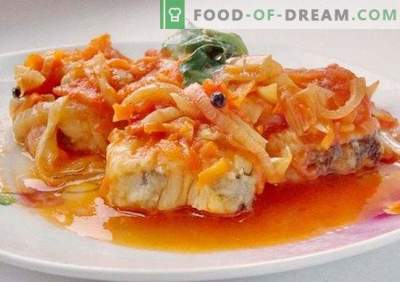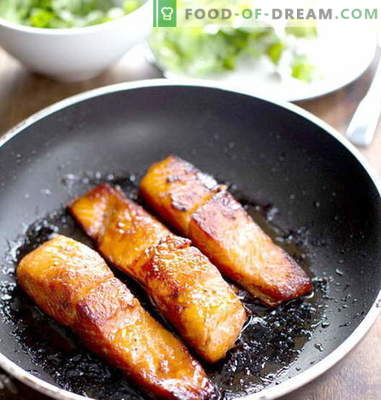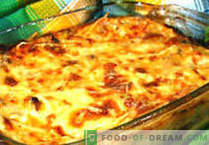
One can talk endlessly about fish, given that it inhabits a large part of the planet - the world's ocean.
To this you can add more freshwater.
But at the moment we’ll dwell on one aspect: fish is one of the most important sources of food for people, and in some countries its use as a food product takes absolutely leading positions.
For example, every Japanese eats an average of 70 kg of fish per year.
In Russia, this figure is much more modest - 24 kg.
Every hour, up to one million tons of fish are harvested in the world's oceans, and that is not counting the fact that in recent decades it has been actively grown in artificial reservoirs.
The nutritional value of fish primarily lies in the special structure of the protein, which, despite its high caloric content, is easily absorbed by the human body, without aggravating consequences. Fish contains the entire range of vitamins and minerals vital to man, and at the same time it is the source of all unsaturated fatty acids. Such a volumetric combination, which almost completely satisfies the human needs for recuperation and maintaining the body’s performance, is rarely to be found in other natural products.
It is known that in the process of cooking, of course, all products lose their valuable properties to a greater or lesser degree. Therefore, the priority task of professionals and housewives in the kitchen is to find the best way to prepare dishes, while maintaining the nutritional value of products, while emphasizing all the best flavors of fish.
How to fry fish in a pan - the basic technological principles
Even with the advent of cooking in its modern sense, the basic methods of heat treatment of fish have not changed dramatically. It is boiled, boiled, stewed, baked and fried. Each of these cooking methods is a fairly voluminous topic, so we’ll dwell on one of them, the most common - frying fish in a pan.
For this method it is recommended to use only fresh fish. Large carcasses are cleaned, washed and cut into pieces, with bones or, after removing them, prepare the fillets, then chopping it into portions. Small species of fish are cleaned, removing the scales, gills and entrails, washed and fried whole, with the head.
In every kitchen of world cuisine in the assortment of fish dishes there is fried fish, apparently, as the most favorite way of cooking.
Fatty fish are chosen for frying. This is due to the fact that at low fat content the flesh of the fish carcass becomes dry and crumbles. But in the case when choosing a variety of fish is not necessary, and the desire to eat registered fried fish is too large, the hostesses who did not study closely the technology of cooking fish dishes begin to look for the answer, why does the fish crumble when frying, how to fry fish in a pan? In flour or in batter (lezone) is the fastest and easiest way to solve a problem.
How to fry fish in a pan in flour
It is not difficult to guess that frying is the most vulnerable method of food processing, during which a significant part of, primarily, the vitamins contained in the products are lost. Of course, it is impossible to completely eliminate such losses, but it is possible to retain at least some of the beneficial properties of food, possessing some knowledge of cooking technology.
Dropping fish in flour before frying is one of the ways to preserve vitamins. The crust formed from frying prevents the release of vitamins from the flesh of the fish and at the same time gives the dish its appearance and taste, beloved by all. The main thing - do not overdo it, so that the flour shell does not burn.
The next important point when frying fish, which also should be paid attention to - is the choice of fat, the topic is also quite voluminous, requiring separate consideration. Let us touch only some of its aspects relating to the question of how to fry fish in a pan. In a good pan with a non-stick coating, you can fry fish without using fat, but there is a nuance here - depending on the type of oil, the fried fish gets additional flavors.
Some species of fish retain their peculiar smell, despite the pre-treatment. If this smell is perceived with pleasure (there are a lot of such fish lovers!), Then use ordinary refined oil, which does not smoke at high temperatures. If you prefer the smell of olives more than the smell of grilled fish - use Extra Virginia oil for frying. You can use high-quality margarine. But real professionals advise to use butter when frying fish. In this case, you need to put a piece of butter under the fish, turning it over to the other side, after frying on one side in vegetable oil with a neutral taste. Natural butter gives a special, delicate taste. In addition, being a product of dairy origin, butter, like all dairy products, successfully removes odors due to its chemical composition.
How much to fry fish
If cave ancestors fried fish on hot volcanic stones and did not think about how much to fry fish, so as not to get infected with those harmful microorganisms that sometimes settle in the sea, and especially in the river inhabitants, what are dishes and how to fry fish in a pan, then modern requirements to the sanitary standards of its processing and storage - a prerequisite.
Before cooking, river fish should be kept in ice water to remove the specific smell of mud, river algae. Since freshwater bodies are the most favorable habitat for various invisible inhabitants of the Earth’s fauna than the salt water of the seas and oceans, the question of pretreatment of river and passing fish should be treated with particular attention. After soaking in fresh water and removing the smell of tina, process the river catch with a strong saline solution. An alternative method of fish disinfection can be processing of alcohol-containing products: wipe large carcasses with vodka or sprinkle with vinegar, soak for half an hour (preferably in the refrigerator), rinse the fish again under running water and proceed to direct preparation without fear of unpleasant consequences. To have absolute confidence in safety, fry fish at a temperature not lower than 150ºC, not less than 10-15 minutes, depending on the size of the fish, followed by bringing to readiness in the oven at 220ºC for five minutes. If you are not going to fry the fish in the oven, then fry it in the pan, turning on both sides twice. In this case, the first roasting is best done with the lid closed, so that the product undergoes preliminary and serious steam treatment. Then remove the lid and fry a second time to get a crisp.
Recipe 1. Fried pelengas with onions, in a “cheese coat”
This fish belongs to the cephalic family. Pelengas - fish, tasty without any additives, and if you want to add a fish dish with other ingredients, then choose neutral foods to emphasize the taste of the fish itself.
Products:
Pelengas 2.5 kg
Grated cheese (any hard variety) 600 g
Oil 82.5% 120 g
Slaw onion 0.5 kg
Breading flour
Salt
Frying oil 150 g
Preparation:
Remove the large carcass from the scales, remove the gills, make an incision on the abdomen and remove the insides. Rinse the abdomen. Large fish can be divided in half along the ridge. In this case, you need to make an additional incision on the back and separate the pulp from the ridge, which, together with the fins, tail and head, are used to cook the soup. Cut the portions, put them in a stainless metal dish and sprinkle with salt. Leave it for about fifteen minutes. Heat the pan and pour plenty of oil so that the fish pieces are half full. Roll the fish in a plate of flour, and place it in the pan when the oil starts to smoke slightly. Fry on both sides and transfer to parchment. Take another skillet, heat again and chop the shredded onions in butter. Top with sliced pelengas and sprinkle with grated cheese. Cover and keep on low heat until cheese is melted. If desired, add the chopped dill and chopped garlic.
Recipe 2. Pikeperch with creamy wine sauce
Products:
Lemon juice 200 ml
Pepper
Pike perch fillet 6 steaks 150 g each
Salt
Butter (butter and vegetable) for frying
Breading flour
To prepare the sauce:
White wine, dry 150 ml
Eggs 2 pcs.
Cream, fatty 225 ml
Salt
Sugar
Muscat, ground 3 g
Preparation:
Prepared steaks are placed in a container, pour lemon juice for twenty minutes. Combine the flour for breading with salt, nutmeg and pepper. Take out the liquid steaks and dry them with a napkin. Dip in the prepared flour mixture and start to fry: first on the heated refined oil, and then turning it over, put 20-25 g of butter under each piece. When frying on the other side, cover the pan with a lid. In a skillet, heat the cream to 40-50ºC, dissolve the salt and sugar in them, season with spices. In a thin stream pour in the beaten eggs, with continuous stirring and heat the sauce to a boil. Pour in the wine and cook for another 5-6 minutes. Removing from the stove, if desired, you can add greens. Serve hot to the fish.
Recipe 3. Milk hake with tomato and vegetables
Composition of products:
Hake carcasses (headless) 4 pcs.
Carrots 150g
Flour (including for passaging) 180 g
Tomato juice 300 ml
Ground coriander
Pepper
Ground Clove
Sugar
Dill, chopped 100 g
Onion 250g
Salt
Spread (72.5%) 200 g
Cooking:
Prepared carcasses of small size salt and dry after twenty minutes with a napkin. Fry on hot fat on both sides, pre-roll them in flour. Chop the peeled onions and cut the carrots into small pieces. Fry vegetables until soft, add flour.
Add tomato juice to taste with sugar, salt and spices; Pour it into passaged vegetables and bring to a boil. Pour the fried fish with the prepared sauce and simmer for 30-40 minutes, adding greens and bay leaf at the end. Serve with mashed potatoes or boiled rice.
Recipe 4. Minty in batter
Ingredients:
Pollock fillet 1.2 kg
Salt
Honey 50 g
Apple Cider Vinegar 100 ml
Soy sauce 25 ml
3-4 rosemary twigs
Sauce:
Sour cream (25%) 200 g
Flour 150 g
Chopped Thyme 50g
Salt 10 g
White ground pepper 5 g
Sesame seeds, fried 100 g
200 g frying spread
Cooking:
Cut pollock meat into strips or cubes, fold them into a container and marinate with honey, salt, vinegar and soy sauce. Mix the marinade with the pieces, put them in a plastic bag, and put fresh rosemary sprigs in it. The package can be left overnight in the refrigerator, tightly tied it.
Just before frying, combine the sour cream with the flour, smash with a blender, add spices, thyme and fried sesame seeds.
Drain the marinated fish pieces with a napkin, breach in flour and, dipping each piece into the cooked batter, put the tongs in boiling fat, frying until done.
Recipe 5. Fried trout with lemon and olives
Ingredients:
Olives 100 g
Trout steaks 2 pcs.
Lemon slices 4 pcs.
Butter, melted 60 g
Olive oil (for frying) 75 ml
Ground Almonds 50g
Flour 120g
Salt, a mixture of ground peppers
Cooking:
Washed and lightly drained trout steaks sprinkle with lemon juice and roll in flour, combined with spices, nuts, and salt. Heat the oil and fry the steaks, 10 minutes on each side. Cover the skillet with a lid for 5 minutes so that the fish steamed, and then fry it again on both sides for 2-3 minutes with the lid open, until it forms a crust.
Serve with slices of lemons, rings cut olives, watered with hot oil.
How to fry fish in a pan - useful tips and tricks
- Before frying fish in a pan in flour, wash it and sprinkle with lemon juice to remove the smell.
- Rub a lemon or rind with a cutting board, knives and dishes after cooking the fish.
- It is better to remove waste after cleaning fish from the room immediately after treatment. This is an extremely dangerous source of infection.
- Fish can and should be included in the children's diet, but children should not eat fried fish. Especially for them, boil a piece of pulp. If the child refuses to eat fish because of its smell, add lemon zest, bay leaf, more greens to fish broth, or combine fish broth with chicken so that the baby doesn’t notice anything, and cook meatballs with rice from fish meat.























